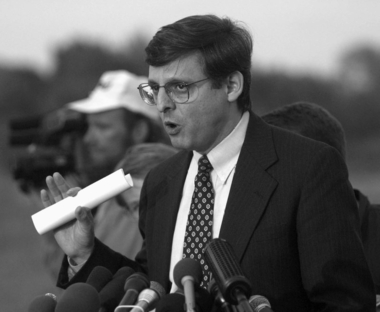Merrick Garland: the unsung hero of the Murrah bombing investigation

by Austin Stallings
Journalism Intern
Just over 21 years ago, the nation was rocked by the largest domestic terrorism attack it had ever experienced. A bomb at the Alfred P. Murrah Federal Building in Oklahoma City killed 168 people, including 19 children in a day care center on the ground floor.
Within days, Merrick Garland would arrive on the scene to supervise the investigation and prosecution. Most Americans would not hear his name again until last month, when President Obama nominated Garland, now a judge, to the U.S. Supreme Court.
The bombing would go on to be a defining moment in Garland’s career.
"We promised that we would find the perpetrators, that we would bring them to justice, and that we would do it in a way that honored the Constitution," Garland said, his voice cracking.
At the time of the bombing Garland was in Washington D.C serving as the right hand man to the deputy attorney general.
The following events were documented by Merrick Garland in his oral history, and researched to a greater extent by NPR.
Within two days, the Justice Department had identified a suspect and was looking for him as Garland boarded an FBI plane headed for Oklahoma City. En route, Attorney General Janet Reno called.
"She said, 'We found him. He's at a jail in Oklahoma. And you're going to be doing the initial hearing tonight,' " Garland recalled in his oral history.
On landing, he drove immediately to Tinker Air Force Base, a secure location where the suspect — Timothy McVeigh — was to be arraigned.
After the arraignment that night, he went directly to the bomb site, where the nine-story federal building was all but obliterated and rescue workers were still searching for bodies. He described the scene in his oral history:
"The site was lit up like ... the day, because of big lights everywhere," said Garland. "The extent of the catastrophe was immediately apparent, a gaping hole in the building and everything. And the worst part was being told ... [that's] where the kids had been."
According to NPR, McVeigh and his collaborators had moved across many states in executing their plot, grand jury investigations were springing up in a half-dozen different states. There were competing local, state and federal agencies involved, including agencies that had lost men and women in the bombing. But the Justice Department was determined there would be one investigation only; the FBI would take the lead, and Merrick Garland would go on to supervise it all from Oklahoma City.
Many people attribute the success of the investigation, as well as bringing Timothy McVeigh to justice to Merrick Garland.
The method of investigation Garland used was crucial in forming a system for investigating acts of terror in the 21 st century.
The Gayly 4/22/16 @ 5:00 p.m.





